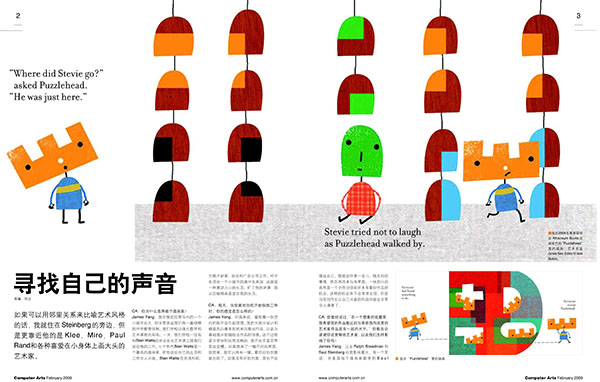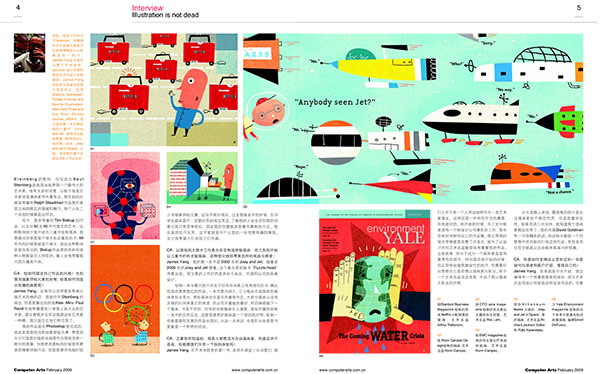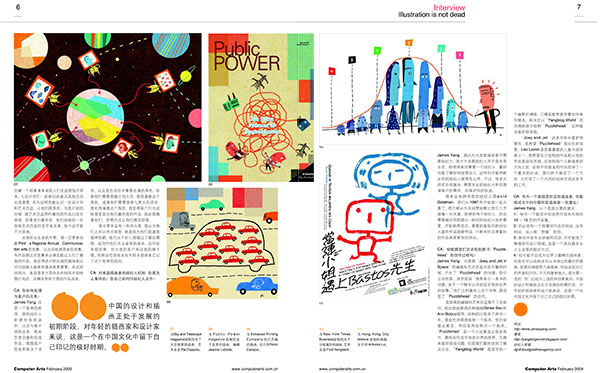Interview with Computer Arts Magazine in China in Spring, 2009. There has been an explosion of new art and design magazines in China.
This is an English translation of the interview.

Computer Arts Magazine Interview with James Yang
1 Why do you choose to be an illustrator?
I grew up in a small town in Oklahoma but was very lucky because we had an excellent high school system. My school was known for having a strong math and art program. One day in art class, we had a former student named Stan Watts come to talk about his work. He was a famous illustrator in the 1970’s and it was exciting to hear about his life and work. He lived in Los Angeles and did album covers, magazines, and advertising campaigns. For a high school student living in a small town, this seemed like an exciting life. After his talk, I decided illustration was the life for me.
2 What’s your feeling when you face the blank paper and begin your work every day?
Staring at a blank piece of paper is not scary. Most of my early sketches for a project are basic shapes to figure out compositions and from this point, I start figuring out ideas for a project. The process is pretty fast and free flowing and I don’t care if sketches turn out badly. If I do a bad sketch, I simply do another sketch. Eventually good ideas happen. If not, I don’t force myself. I will take a break, do something else, then come back to sketching later. A blank canvas is a chance to create the best image you have ever created. It doesn’t happen often, but it is very satisfying when you do create something that makes you excited.
3 As you said, “I wanted my work to fit if placed in an imaginary collection with the work of artists I admire.” Could you tell us who are they? And how did they influence u?
In the past, my big influences were Ralph Steadman and Saul Steinberg. There is a joke that every illustrator in the US is influenced by Steinberg because he is one of the first great artists in publishing. He had so many ideas and there were arguments whether he was an artist or cartoonist. Ralph Steadman was a huge favorite of mine when I was younger because of the insane emotion and energy of his work. This makes sense since every guy in his 20’s has crazy amounts of energy and emotion.
Today I really like the work of Tim Biskup and the retro looking art from the 50’s to 60s. This influence started happening when I started doing children’s books and I wanted to do books I would have liked as a child. I was a child in the 60’s so the influence is obvious. The colors and the variety of characters in Biskup’s work is amazing. He looks like he is having fun when he paints.
 4 How to describe your style by yourself? How do you create the funny picture that people likes when you use the collage elements?
4 How to describe your style by yourself? How do you create the funny picture that people likes when you use the collage elements?
If art styles were neighborhoods, my style lives on the edges of the Steinberg neighborhood, but nearby are the Klees, Miros, Paul Rand, and various artists who love to draw big heads on smaller bodies. Please remember I am not saying I am as good as these artists, I just live in the neighborhood
My work is done in Photoshop so if I use collage elements, they are images scanned into my computer which is saved as part of a visual library. I did more collage work when I used paint, but use less collage with the computer which seems opposite. When I used to teach, I would tell students illustration ideas are visual jokes which don’t have to be funny. People who know me will tell you my ideas are similar to how I think naturally so my ideas are just the way I see things. I’m always joking around so this might be why some of my ideas are funny. At least I hope people find them funny.
5 Most of your job is an illustrator works for magazine and newspaper before, as we know you start to work for children’s book form last year, would you tell us what’s your challenge and feeling for this change?
My first book was Joey and Jet in 2002, then Joey and Jet in 2006. This spring my new book, Puzzlehead will be released in the Spring. The main part of my work is still projects from magazines, agencies, and companies.
The biggest difference with doing a book is you have time to really think about your book and make sure you are happy with the art. A book is more permanent and is very different from doing magazine or newspaper work which is read today and forgotten tomorrow. When you do most projects, there is never enough time to really think about the project, so you do the best you can and move on to the next project. Books are different. You have the time to make things right. I really like the reflective nature of working on a book and it is a nice contrast to my normal work. It is also nice to work on something that grows and evolves. You look at a book while in progress and always see things you can change. At this point in my career, books are still more of a side project.
6 As you know, there are so many people want to be a free illustrator, but it not too easy. Could you share your experience with us?
My first day of art school in college, the teacher told us only one of us in class would end up making a life as an artist. It was a very scary thing for him to say, but he was right. When I first started out, I had a part time job with a design firm to pay the bills and I would work during my free time on my portfolio. I remember spending many days in waiting rooms for designers and art directors to quickly look at my work. It was a difficult, but very educational part towards becoming an illustrator. You have to learn to accept criticism constructively and you need to be very focused if you want to make a career as an illustrator, expecially at the beginning. Finally one art director decided to use me and this started me on my way to a career in illustration.
The hardest part for most people is the unsteady nature of freelancing, but I like this part of the work. Every illustrator I know freaks out if the phone doesn’t ring for a few days. My agent, David Goldman has a great saying. He says every day is a chance for the project of your dreams to call you. There have been many projects that were complete surprises which makes freelancing fun.
7 How do you become so much popular? How did you introduce and promote yourself to reader and client?
If I were starting out today, I would make sure to have a website with my illustrations because this is how art directors and designers discover work. You need to create a mailing list of people to send a postcard samples. It is also important to go to lectures and other events with designers so you can meet designers and art directors and make connections. Back when I started, it was easier to make an appointment with an art director to look at your work and if they liked you, they would give you a names of other art directors to meet. This may not be so easy today.
Early in my career, I made sure to enter competitions like Print’s Regional Annual, and Communication arts, as well as other competitions for illustrators. Having work accepted in these competitions really helped people to know my work. I feel this is more important for beginning illustrators than for established illustrators. During this time, many of the large magazines and newspapers in the United States started calling me which really helped my work become known.
 8 How do you deal with the relationship between clients?
8 How do you deal with the relationship between clients?
It is a simple process. My agent handles all of the negotiating and business part with clients, and I handle the creative and execution part. My relationship with the client depends on the project and the role I need to play in the project. If they need me to be the main creative guy, I am comfortable with this role or if they need me to be a part of a bigger project, I am also comfortable in this role. I feel clients call because they like my work, so I treat them with respect and try to make them feel comfortable.
I am very lucky to have clients who call back and I think they call back because they know I am realiable and they never have to worry about me missing a deadline or creating illustrations that are unnacceptable. This may sound very simple, but I am also nice to my clients. You would be surprised how many illustrators forget this simple rule.
9 What’s your comment on the professional agent of an illustrator? What’s the Pro & Con of this? As an illustrator, how do you work with agent?
I don’t think most illustrators need agents because most of the agents in the business are not very good. Even if you want an agent in the future, it is good to learn how to do the business side yourself so you can tell if your agent is doing a good job. The best argument for having an agent is many big projects are complicated to negotiate as far as usage and rights so it helps to have someone negotiating for you.
I am lucky because my agent, David Goldman, and I have been together since 1987. We both think alike when it comes to business strategy and we are almost like a married couple. Even if you have an agent, you need to do your part and give the agent what he needs to be successful. It is important to provide the agent with fresh samples of your work and keep your website updated with your recent best work.
10 Would you tell us the creation processing of new book “Puzzlehead” ?
The idea for “Puzzlehead” came up while I was having lunch with my editor and art director for “Joey and Jet in Space”. We were eating and suddenly, I said, I have an idea for a book! It’s about puzzle-shaped person looking for where he fits in the world! They immediately liked the idea and gave me a contract for “Puzzlehead”.
My original editor and art director had left the publisher so I was put with my new editor, Ginee Seo, and Ann Bobco. The writing process took almost a year. I would write a version with sketches, and they would make comments then I would right another version. “Puzzlehad” had to be journey of a character trying to fit in many places before he found the place he fits. The writing was a problem, but we finally found a solution. “Yangblog World” is a humourous blog I write and it really helped me learn how to write. I decided to write “Puzzlehead” in a “Yangblog World” style for chldren, and this approach really worked for the book.
The “Joey and Jet” books have rich colors for the backgrounds and I knew I wanted “Puzzlehead” to have white backgrounds. Leo Lionni is one of my favorite children book illustrators and I wanted to do images inspired by his work. It took a summer of doing different versions of the art before everybody was happy with the direction. We finally agreed on a direction and it took about a month to do final art for the book.
11 As a popular illustrator in USA, would you give some advice for Chinese young illustrator?
Here is my main advice:
1) create a portfolio of at 10-15 pieces which shows a consistancy of your style.
2) You have to have a website of your work. If you don’t have a website, nobody can discover you.
3) Go to as many professional lectures and events as possible to learn about the illustration and design field. This is an excellent way to meet professionals in person.
4) You may not be the best illustrator in the world, but you can do the best illustration you have ever done. If you keep trying to do this, you will find your voice and direction. Try not to be a copy of someone else. It is better to be a first-class you instead of a second-class Picasso. The design and illustration field in China is still young. This is an excellent time in history for young illustrators and designers to make a mark on Chinese culture.
Nice to hear from you Judy! I can’t believe Jessie is now ready for college. I have many good friends who are RISD grads who are doing well in the field so that would not be a bad choice either.
James, I just read this interview out loud to my daughter, Jessie, whom you may remember has “wanted to be an artist when she grows up” ever since she can remember. She is now eighteen, preparing to graduate from high school, and planning to major in Illustration…possibly at your alma mater ( though RISD is very tempting) starting in the fall.
As I was reading aloud, I could totally visualize you saying all of this. It is so straight forward James Yang: simple, direct, sincere, honest, wise, and extremely insightful. Thank you so much for this and all of the cool stuff on your website. Planet Yang is such a valuable tool of inspiration for young illustrator hopefuls like Jessie. Your work is amazing and you set the bar high. :-)
I really liked your article write more..i will add you to the favorite
Thank you for providing this inspiring read. Check out mine!
I wish I was so good!